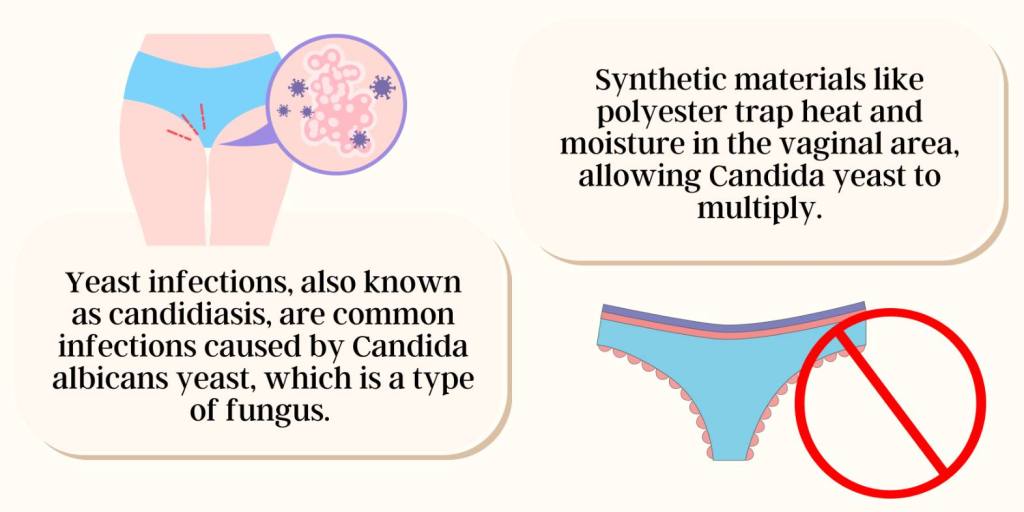Our intimate apparel is in 24/7 contact with our bare skin. Yet many underwear options today are made from polyester and other synthetics. These fabrics may seem convenient, but are they suitable for something worn so close to the body? In the following guide, we dive into the question, ‘is polyester good for underwear?’, exploring the fabric through the lens of fertility, intimate health, and hygiene.
Is Polyester Good for Underwear?
Polyester, a toxic petrochemical fabric, can suffocate your intimate area and decrease fertility. Studies show that its inhibits your reproductive potential, promotes yeast infections, and exposes the body to toxins.

Polyester Underwear Decreases Fertility
Who would have thought that something as innocuous as underwear fabric could sabotage fertility? Well, a recent study discovered that regular polyester underwear silently decreases sperm count.
Intrigued by the potential impacts of fabrics on fertility, a 2021 study explored how different underwear materials affect sperm production in dogs. Researchers divided 24 dogs into 2 groups of 12 – one wearing 100% cotton underpants, the other 100% polyester, for 24 months.
The study analyzed the dogs’ semen samples, testicular biopsies, and hormone levels monthly, and what they found is alarming. After only 12-16 months, the polyester group showed significantly decreased sperm count and motility, with more abnormal shapes. By 24 months, all polyester dogs showed poor semen quality, accompanied with testicular degeneration.
This occurred in the absence of heat or overly tight underwear – the pants were made to be loose-fitting to avoid insulation. However, the former factors could lead to even more harmful effects.
Interestingly, 10 of 12 dogs recovered normal sperm counts within 12 months of removing the polyester undergarments, which further demonstrates polyester’s role in the fertility shifts.

How Does Polyester Inhibit Reproduction?
So, in the aforementioned study, how did polyester impair dogs’ sperm production without heat or constriction? Researchers hypothesize the fabric generated negative electrostatic charges through friction on the scrotum. These induced positive charges on the inner scrotal skin surface, creating an “electrostatic field” traversing the scrotum, ultimately, disrupting cellular function.
While further research is needed, this study rings alarm bells on potential fertility impacts of synthetic fabrics. The scrotum and testes are incredibly delicate organs, where seemingly minor external factors can dramatically affect sperm production.
Hence, for people struggling with infertility issues, it’s crucial to switch from synthetics to natural alternatives to ensure optimal reproductive health.

Polyester Underwear Causes Yeast Infection in Women
Polyester underwear promotes yeast infections in the nether regions by culturing fungal blooms and fueling inflammation, according to recent research.
Through the impermeable synthetic weave of polyester, bodily fluids and heat can’t escape. So, as undergarments incubate this damp, dim environment, they essentially transform into petri dishes thriving with candida.
Why would seemingly benign panty fabric lead to pathogenic inflammation? The culprit is poor moisture control. Unlike natural fabrics that wick moisture, polyester retains heat and fluids in the intimate area, which fosters micro-environments that make it easier for fungal infections to thrive.
A 2021 study embarked on a mission to investigate this effect. It found that post-bariatric surgery patients, having lost significant weight rapidly, developed infected rashes in between newly formed skin rolls and crevices.
When these patients wore loose-fitting, breathable cotton underwear, their skin afflictions decreased by 70%. As researchers hypothesize, all the amazing airflow properties of cotton dissipated the heat and fluids in the skin creases that drove fungal overgrowth.
Additional investigation is still required into the mechanisms linking underwear fabric to yeast infection development. However, current evidence suggests that cool skin prevents contact dermatitis and secondary infections, which makes natural fabrics more optimal for underwear overall.
Polyester Underwear Contains Toxins
Unlike breathable natural fibers, polyester traps heat against the body, creating a higher chemical absorption risk in delicate regions. This is alarming, considering that polyester itself introduces a myriad of toxins into the intimate area.
In fact, studies reveal carcinogens, hormone disruptors, heavy metals, and allergy-provoking dyes lurking within polyester fibers. Direct skin contact, moisture, and heat – all enable migration of these toxins from pants into the body, especially across the intimate area, which is one of the most sensitive parts of your body for chemical absorption.
While some experience immediate rashes or nausea when donning brand new polyester garments, the true harm builds up slowly over the years as toxins bioaccumulate. Respiratory distress, dermatitis, eczema and more may all manifest eventually.
Even the workers producing such dye-laden synthetic fabrics face health issues from hot pressurized vats, as insoluble pigments present in polyester harbor lead, chromium, and irritating phthalates.
Steer Away From Tight Polyester Underwear
Tight-fitting polyester underwear combines two risk factors – the abrasive, irritating fit and the moisture-trapping properties of the fabric.
Studies show that tight underwear restricts airflow and traps heat against the skin. However, the proximity of the fabric to the intimate area can additionally cause friction, spawning microscopic irritated lesions in the vaginal lining. As a result, yeast and bacteria can breach this protective outer layer more easily.
Yet, this is not the whole story. As the synthetic fabrics get heated up faster than their natural counterparts, polyester makes the intimate area absorb toxins more readily. It is for this reason that regular wear of synthetic hygiene products, polyester underwear, and nylon tights is considered a risk factor for vulvovaginal candidiasis (VVC).
So, to prevent the opportunistic Candida fungus to multiply into a full-blown infection, it’s crucial to avoid tight-fitted garments engulfing the intimate area and choose natural, breathable fabrics instead.
More Fabrics to Avoid in Underwear
Apart from polyester, other common underwear fabrics that may have similar health effects include:
- Rayon
- Acrylic
- Nylon
- Polyester satin
- Spandex
- Lycra (a type of spandex)
- Conventional, that is, non-organic natural fabrics (more on this later).
The Intimate Area is More Sensitive to Toxins
Nurturing new life, the genital area has sacrificed safety for sensitization. It has developed greater sensitivity not only to sexual pleasure but also toxins – more so than other regions of the body.
With its one-of-a-kind structure, the intimate area is thin and vascular by nature. Considering such high level of vulnerability, it’s crucial that you find all your answers to the question, “is polyester underwear good for you?”, so that you can assess the risks posed by the fabric carefully and protect your intimate health.
Why The Intimate Area Is So Sensitive to Polyester
The non-keratinized vaginal and vulvar tissues possess a different structure, as compared to keratinized skin. These areas are likely to be more permeable to external substances.
Additionally, the vaginal barrier does not have a thick lipid layer to control moisture loss across the tissue. This lack of a protective lipid envelope causes the vagina to be vulnerable to increased temperatures from fabrics like polyester that can alter its moisture balance.
Considering this, it’s wise to steer away from toxic polyester, as it creates an electrostatic charge that succumbs the intimate area to heating stress. Ultimately, the fabric leaches chemicals onto the area faster, due to its lack of thermoregulation, posing risks to fertility in both men and women.

Recycled Underwear Means Synthetic Underwear
Have you noticed the recent surge in recycled underwear? From 2022 to 2023 alone, bras described as ‘recycled’ have proliferated by 266%, as brands like Adidas, Athleta, and Free People have invested in recycled collections. However, these seemingly sustainable items are made of synthetic materials, which defies the purpose of green consumption.
When taking a look at the fabric composition of recycled underwear, we can see that it comprises of recycled nylon, polyester, and polyamide. For instance, a recycled bra from Free People contains 68% recycled nylon, 29% nylon, and 3% spandex, which are as toxic, heat-trapping, and harmful as virgin polyester.
Yet, greater concerns emerge when it comes to recycled polyester, which may be more harmful than its regular polyester. The reason behind this is that recycled polyester is made of PET bottles, which get sprayed with chlorine in the process. Additionally, recycled polyester may contain BPA residues that leak from the input materials, that is, post-consumer plastic bottles.
For this reason, we urge you to not fall for the deceitful ‘recycled’ label, as it doesn’t necessary imply non-toxic. When shopping for underwear, always ditch synthetic fabrics, regardless of whether they’re made of virgin or recycled materials.
Why Natural Fabrics Are Better for Underwear
We want our underwear to not only benefit the environment but also us, the wearers. This means that it should be made of natural fabrics that don’t shed microplastics, are biodegradable, and soothe our intimate skin.
Read on to understand the benefits of natural fabrics for underwear.
Regulation of Temperature
It’s no secret that the intimate area is prone to moisture buildup, sweating, and secretions. So, maintaining proper thermoregulation is essential, as it inhibits the growth of bacteria and prevents unpleasant odors.
Apart from regular bathing and changing of underwear, we recommend that you wear natural underwear, made of linen, cotton, and bamboo, which possess unmatched thermoregulation properties. These fabrics are known to buffer the skin from summer heat while providing warmth in cooler months. So, they are sure to keep the intimate dry and cool throughout the day.
Breathability
Moreover, natural fabrics allow for increased breathability due to their woven structure and moisture-wicking properties. Unrestricted airflow keeps the skin dry and reduces the risk of fungal or bacterial overgrowth – therefore, natural fabrics manage to ventilate the intimate area optimally.
Moisture-Wicking Capabilities
In addition to breathability, natural fabrics absorb moisture through their absorbent fibers. Cotton efficiently whisks perspiration away from the skin surface, helping maintain a comfortably dry environment. Similarly, linen absorbs 20-35% of its weight in moisture before starting to feel damp, making it uniquely equipped to wick moisture away from the genital region.
Preventing extended moisture contact with skin crucially reduces infections, where microbes readily multiply if left damp. Thus, the moisture-management of cotton and linen clearly advantages them over synthetic underwear choices.
Skin-Soothing Properties
In addition to their functional benefits, natural textiles like cotton, bamboo, and linen have an inherently soft, smooth, and gentle texture against skin. Their delicate nature suits sensitive regions exceptionally well, preventing inflammation and irritation that can be caused by stiff, rough synthetic blends.
Where thinner intimate skin is prone to chafing, natural fabrics provide a soothing coolness and crispness that prevents discomfort.
Natural Underwear as a Toxin-Free Alternative
Frightened by polyester’s dangerous properties, many shoppers prioritize natural fabrics for underwear. However, that comes with a hidden issue. Natural fabrics aren’t always organic – they may contain toxic finishes, allergens, and harmful dyes just like polyester. For this reason, we recommend that you prioritize organic natural fabrics.
Organic fabric cultivation methods exclude the use of synthetic pesticides, fertilizers, and GMOs that can deteriorate soil and water quality. Their by-products pose absolutely no threat to marine life ecosystems or our planet as a whole. However, the benefits of organic fabrics extend beyond the environment.
When organic, natural fabrics are toxin-free. They are free of harmful dyes, harsh chemicals, and pesticide residues, protecting you from a myriad of health concerns.
So, as we’ve answered your concern, “is polyester underwear good for you?”, pick out natural underwear that’s GOTS and OEKO-Tex 100 certified. The former ensures that the presence of organic materials, while the latter indicates absence of toxic garment finishes and hazardous dyes.
Conclusion
In the vast sea of undergarment options, many are questioning the safety, environmental friendliness, and overall impact of polyester undergarments. After all, brands often label them as ‘moisture-wicking’, ‘high-performance’, and ‘long-lasting’, which sound appealing to many.
However, it’s worth pondering, “is polyester underwear good for you?”, before letting the fabric invade your sensitive intimate area. Polyester is a petrochemical fabric that’s poisoning us and the planet. In the form of underwear, it inhibits reproductive health and increases risks of yeast infection. For this reason, it’s wise to steer away from the fabric and prioritize natural, organic options instead.

